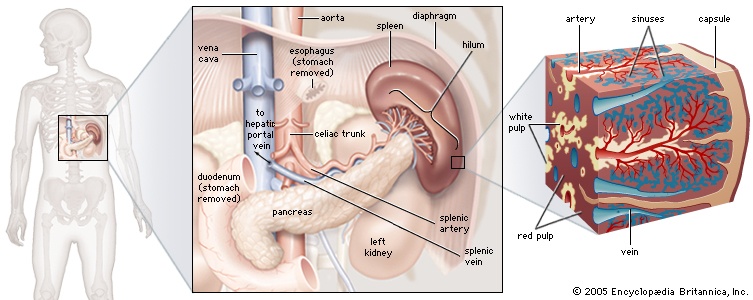spleen
anatomy
 organ of the lymphatic system located in the left side of the abdominal cavity under the diaphragm, the muscular partition between the abdomen and the chest. In humans it is about the size of a fist and is well supplied with blood. As the lymph nodes (lymph node) are filters for the lymphatic circulation, the spleen is the primary filtering element for the blood.
organ of the lymphatic system located in the left side of the abdominal cavity under the diaphragm, the muscular partition between the abdomen and the chest. In humans it is about the size of a fist and is well supplied with blood. As the lymph nodes (lymph node) are filters for the lymphatic circulation, the spleen is the primary filtering element for the blood.The spleen is encased in a thick connective-tissue capsule. Inside, the mass of splenic tissue is of two types, the red pulp and the white pulp, which do not separate into regions but intermingle and are distributed throughout the spleen. The white pulp is lymphoid tissue that usually surrounds splenic blood vessels. The red pulp is a network of channels (sinuses) filled with blood, and it is in the red pulp that most of the filtration occurs.
The white pulp of the spleen contains such typical lymphoid elements as plasma cells, lymphocytes (lymphocyte), and lymphatic nodules, called follicles in the spleen. Like the lymph nodes, it reacts to microorganisms and other antigens (antigen) that reach the bloodstream. Phagocytic (phagocytosis) cells in both red and white pulp serve to remove foreign material from the blood and initiate an immune reaction that results in the production of antibodies (antibody). Germinal centres in the white pulp are sites of lymphocyte production.
The red pulp has a specialized role in addition to filtration. It is the body's major site of the destruction of red blood cells (erythrocyte) (erythrocytes (erythrocyte)), which normally have a life span of only 120 days. Degenerate red cells are removed from the circulation in the spleen, and the hemoglobin that they contain is degraded to a readily excretable pigment and an iron molecule that is recycled (i.e., used to produce new hemoglobin elsewhere).
In some species the spleen also acts as a reservoir for blood during periods of inactivity. When such an animal is aroused for defense or flight, the capsule of the spleen contracts, forcing additional blood reserves into the circulation. The human spleen probably does not have this capability.
- nevus
- Nevşehir
- New Age movement
- New Albany
- New Amsterdam
- New Apostolic Church
- Newar
- Newark
- Newark and Sherwood
- Newark-on-Trent
- New Bedford
- New Bedford in Moby Dick
- Newberg
- New Bern
- Newberry
- Newbery Medal
- Newbolt, Sir Henry (John)
- New Braunfels
- New Britain
- New Brunswick
- New Brunswick, flag of
- New Brutalism
- Newburgh
- Newburn
- Newburn, Battle of